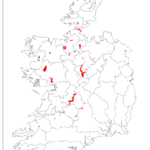Changes to the hydromorphology ranks as the second most significant…
Significant Pressures: Drained Peat
Peatlands account for approximately 20% of the land area in Ireland. Peatlands provide a range of functions, including maintaining biodiversity, carbon storage and sequestration, water quality, and regulation of flows. Peat extraction for commercial or domestic purposes, and modification or drainage of peatlands for other uses such as forestry or agriculture, has been identified as a significant pressure in just over 6% of waterbodies that are considered ‘At Risk’ of not meeting their water quality objectives.
Waterbodies are categorised as being ‘At Risk’ of not achieving its WFD objectives where the monitoring data shows evidence that water quality is impacted, and actions are required to deliver water quality improvements. Based on the most recent characterisation assessment, using data up to 2021, this is the eighth most prevalent significant pressure type and is related to a mixture of licensed (50%), unlicensed (23%) and other activities (27%).







